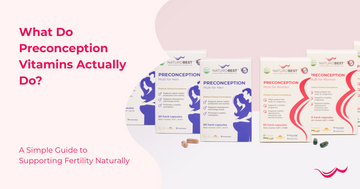Basal Body Temperature: How to Know When You're Fertile
by Danielle Maguire on Feb 01, 2022

Guest post by Dr Danielle Maguire, Integrative Chinese Medicine Practitioner
Q: What’s one thing that can help your fertility, is basically free and takes less than 1 min per day??
A: Fertility Temperature Charting, otherwise known as Basal Body Temperature Charting (BBT)
Fertility can feel like such a mystery sometimes! When we were younger, we spent so much time & energy on ensuring we didn’t fall pregnant.
Then when you want to start a family, fertility can feel really complicated and frustrating with Google searches & forums yielding almost no information that relates to you specifically.
This is where Basal Body Temperature (BBT) charting comes in. Our fertility focused Chinese Medicine Clinic, ALL of the lovely women working with us to conceive do BBT charting.
The info these charts provide is pure gold for fertility practitioners who are trained to read them! Charting temperatures isn’t a new thing. It seems way too simple to actually be helpful, so why is BBT charting so important when trying to conceive?
Well, this personalised information allows us to ‘see’ exactly what’s going on with your hormones, ovaries & uterus. If you’re seeing a Chinese Medicine Practitioner, it allows them to personalise which acupuncture points, herbs & supplements they prescribe. (more on how Chinese Medicine can help with fertility here). It allows us and the clients to track progress to ensure what we are doing is correct & working.
What info you can you get from BBT charting?
- Are you timing right? If you’re timing for conception on day 14 ovulation and you don’t ovulate until day 20, you may be missing your fertile window.
Fertility or period apps that don’t record temperatures are just guessing. Guessing that your fertile window will be mid-cycle – it's not always the case!
-Is the issue in the first follicular half of your cycle? (e.g. ovulating late)
This can relate to FSH, iron, thyroid levels, egg quality or inflammation.
- Is there an issue with ovulation? (e.g. getting periods but not ovulating)
This may relate to various factors. Factors such as LH levels, inflammation or prolactin. Or other factors like egg quality, inflammation or polycystic ovaries.
- Is the issue in the second Luteal half of your cycle? (e.g. a short time from ovulation until your period)
This can relate to progesterone, iron, thyroid or egg quality.
- Is there an issue during your period? (e.g. very light, very heavy or very clotted periods)
This may indicate an issue with oestrogen, iron, thyroid or inflammation.
- Are you making progress?
It's hard to remember what your period was like 2 months ago. Let alone how much fertile mucus you had and when you had sex in previous months!
You can pop all that info + more into your chart so you have it all on file. Plus, you can see the changes in your charts that reflect your health and fertility improving.
What else can you learn from BBT charting?
- If/when you are actually ovulating! This is beyond important info and sometimes it is that simple! You can get periods without ovulating. Your ovulation day can vary each month too.
- In some women, BBT charts show ovulation better than ovulation test kits. This is because you can have small rises in luteinising hormone without ovulating yet - and charting is so much cheaper!
- Allows you to double-check that your IVF procedures like egg retrieval and embryo transfers are being done at the right time. Right time according to your hormones.
- Alert you to get your thyroid fully tested by a GP if your temperatures are consistently really low or really high
Allows you to see how something you're doing is affecting your health. Maybe that hardcore spin class feels good. But if it's consistently lowering your temps the next day, it's too much and you need to reduce it.
So how do you do BBT charting exactly?
- Buy an ovulation thermometer (less than $25), it needs to have 2 decimal places eg 36.54’C
- Download a temperature charting app – my personal favourite is the free version of Fertility Friend App. Though not as pretty as the other apps, it's much easier to read and analyse. (I have no affiliation with this brand, just sharing what I love & use!)
- Put the thermometer in your mouth. Between your back teeth and the root of your tongue and hold it there until it beeps. Either enter the data into your app or turn it off, go back to sleep and record it later
- Do it as soon as you wake up*, before having water.*If you wake up at 6:30 and hit snooze until 7am, take it at 6:30. If you wake up in the middle of the night to pee, just go back to sleep and take it when you wake up for the day.
- If you have to get up early like 4:30am for your charming tiny human or some other reason. Take it then and make a note in your app. Or have a second thermometer in their room so you can soothe your little one & take 30 secs to record your temps.
Things to consider:
- If you’re still on hormonal contraception, BBT charting won’t be beneficial.
- It might take a couple of cycles for you to get the hang of it. As well as to be able to interpret your hormonal picture properly but this is such important information about your body!
- If you want to track your cycles but do NOT want to conceive. I recommend investing in the thermometers with an inbuilt computer (about $300). This will interpret the data for you and with high accuracy tell you when you are or aren’t fertile.
This may not be enough to completely solve your fertility mystery but it's an excellent place to start. As well as to have personalised health info to share with a fertility practitioner & track progress!
Want some additional help with your health & fertility?
We’re at Embrace Acupuncture located in Northcote, Melbourne with in-person and online appointments available. Happy Charting! Dr Danielle Maguire, Integrative Chinese Medicine Practitioner




